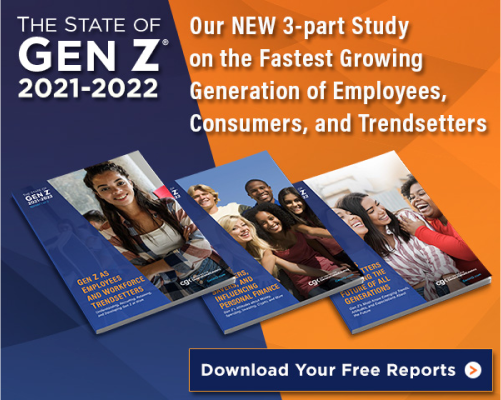
And now to the Q&A insights…
For the first time ever, many businesses, organizations, and nonprofits are employing five different generations at the same time. That’s right. Five generations! This means leaders are recruiting, retaining, training, communicating, and seeking to drive innovation with Gen Z, Millennials, Generation X, and Baby Boomers at the same time. All of this makes it an exciting moment to share our research discoveries from nearly 100 research studies we’ve led around the world!
As you can imagine (and probably have experienced firsthand!), it is more important than ever to accurately understand each generation to effectively communicate, engage, and lead each one in the workplace. In fact, we’d argue that it’s mission-critical for leaders to cross the generational divide at work if their organization (and career) is going to thrive now and long term.
At The Center of Generational Kinetics (CGK), we define a generation as a segment of a geographically linked population that experiences similar social and cultural events at roughly the same time in their maturation, leading to increased predictability by scenario. In other words, a generation is a group of people born about the same time and raised in about the same place. This is often referred to as a “birth cohort.”
From our research-based focus at CGK, it is important to highlight that geography plays a big role in shaping generations. However, the impact of geography is rarely talked about in conversations or presentations about generations. We are on a mission to fix that knowledge gap!
For example, you’ll often see differences within the same generation in the same country depending on whether someone was raised in a rural area or urban area. You’ll also see differences within the same generation as you travel and work around the world. One priority for our team at CGK is making sure that we always incorporate the influence of geography when analyzing our studies, in our custom speeches around the world, and when solving client challenges.
In other words, what works for engaging Gen Z or Millennials in Kansas may not work with Gen Z and Millennials in Paris, Mumbai, or Singapore. Knowing and understanding the role geography plays in shaping generations expands your perspective to uncover exactly what works with different generations around the globe.
Another key trend that shapes generations: Technology.
Our research has shown that every generation has a different natural relationship with technology—which is largely driven by their age. This has a lot to do with each generation’s introduction to new types of technology, from the entry of remote controls and smartphones to color TVs and microwaves. Yes, microwaves.
One of our most famous discoveries at CGK, and the one Jason is most often quoted saying in the media, is that “Technology is only new if you remember it the way it was before.” This helps to explain both the resistance and adoption of new technology, along with how it impacts everything from customer expectations to recruiting each generation of employees.
From face-to-face conversations at a coffee shop to embracing distance learning and telemedicine—it is our natural relationship with technology that influences so much of how each generation communicates and connects. At CGK, we invest a lot of time studying generational drivers, preferences, and emerging trends around technology because it is one of the best ways to increase innovation, sales, marketing, loyalty, recruiting, and growth.
When it comes to the financial services industry—which is the audience for the MarketFacts platform—they are in a particularly challenging time. There is a massive generational change affecting how people search for, purchase, and use financial products, as well as how different generations seek to invest and think about risk and retirement. At the same time, the industry often skews older in terms of financial advisors, so it is especially important for the industry to effectively and quickly adapt to attract the next generation of talent and clients.
As leaders, it is our strong belief that now is the time to assess, understand, and unlock each generation’s potential within a multi-generational environment.
While every business, role, and responsibility has different constraints as well as ways to measure success, we do know that understanding and better engaging each generation consistently drives valuable results. For example, our research has uncovered that many in Gen X are at a crossroads in their careers—figuring out whether to stay where they are and finish out their career or make one more move to another organization. Retaining Gen X right now is critical as they often are the key bench of talent for senior leadership roles.
Despite the memes and cable news headlines proclaiming Millennials as not working, the research-based truth is that Millennials are the largest generation in the workforce. Part of this is due to many people not realizing that the oldest Millennials are now over age 40 (gulp!), but also the proliferation of myths and misinformation that claim all Millennials are lazy and entitled. It’s just an unfortunate stereotype that has stuck in spite of the fact that there are inspiring, hard-working, creative, and loyal Millennial leaders in organizations around the world. Recognizing that Millennials can be hard-working, loyal employees and outstanding leaders helps to reframe the conversation and create the space to unlock their talent and potential.
And now…drum roll please…we welcome the fastest-growing new generation to the workforce and as consumers: Generation Z.
This new generation is now up to age 25 and brings a fresh, exciting perspective to the workforce, adulthood, and the world. Already, this diverse generation is driving new technology adoption, greater emphasis on work-life balance, a clear desire for organizations to support social causes, and a willingness to dig into big problems that need to be solved. In our work with companies to future-proof their business, making sure to unlock the potential of Gen Z—and really understand their motivations, perspectives, and strengths—is pivotal to ensuring long-term success.
Today’s leaders and organizations must recognize (and many do) that their workplace strategy cannot be one-size-fits-all anymore. With five generations in the workforce, leaders need to update their strategies for communicating, motivating, and retaining each generation. Doing so does not create more work for leaders—instead, effectively adapting to different generations actually reduces the amount of work and stress by enabling leaders to be more effective with less effort. Everyone wins, too, as each generation feels more valued, inspired, and included.
So, where can you start to unlock the potential of each generation, from Gen Z to Baby Boomers?
Our recommendation is to create a generational snapshot of your current organization. This is a pie chart that shows the percentage of each generation currently in your workforce. Taking this one step to accurately visualize the percentage of generations within your workforce is always an “aha” moment because rarely does the generational mix match the perception within the organization. This also breaks down barriers to see which generations are growing on a percentage basis and what the organization could look like in 2 to 3 years. Starting with accurate data is always the best place for informing generational strategy.
Circling back, there is no doubt that Gen Z’s influence on the future of business, work, client trends, and communication is already massive and only going to grow—and even influence Baby Boomers (just ask many a grandparent how they like to talk with their grandkids on FaceTime!). However, leaders still need to make sure and continue to take action to engage each generation within the workforce and marketplace. Doing so brings out the best every generation has to offer.
“Understanding generations accurately can create advantages and help companies build strategies that drive short- and long-term growth. This [financial services] industry has five generations within its organizations. This is truly a once-in-a-generation moment because there is only one time period when a new generation emerges, and we just happen to be in it right now. I think the risk to the industry is not being ready for the next generation. Many companies adapted too late to Millennials and then spent years trying to play catch-up to win that generation. The one thing that the industry can do now is to pay close attention to Gen Z, so they don’t repeat that; and instead, they can unlock the potential of the generation now at this critical time.”
It is an exciting time to study Generation Z as they further enter adulthood—and to continue our research studies of every other generation, too! At The Center for Generational Kinetics, we will continue closely studying the generational change within the workforce, marketplace, and world unfold and share our discoveries with you.
Thank you for being on this journey of research, insights, and discovery with us. Be on the lookout for our new State of Gen Z® Crossing the Generational Divide study coming soon!
